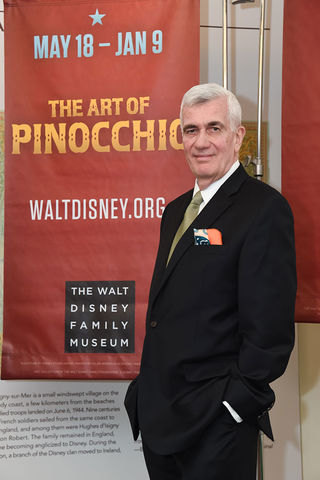
On Saturday, May 21, 2016, John Canemaker, guest curator of Wish Upon a Star: The Art of Pinocchio, took guests on an in-depth exploration into the works of two great animation legends: Vladimir Tytla and Milt Kahl. Canemaker discussed Disney’s extraordinary film, Pinocchio, focusing on Tytla and Kahl, their creative process and individual styles, and how these two creative masters cemented their places in animation history.
The Start of Pinocchio History
Canemaker—an Academy Award®, Emmy Award, and Peabody Award-winning animation director and designer—opened the talk by discussing Pinocchio’s early beginnings. Written by Carlo Collodi, The Adventures of Pinocchio appeared originally as an illustrated serial in Italy in 1881 and 1882, before being turned into a children’s book in 1883. This presented Walt Disney with the challenge of adapting a multitude of adventures into one succinct story. Walt enlisted his best animators to create that story and what would eventually be considered one of the greatest animated films ever made. Two of his best animators, Vladimir Tytla and Milton Kahl, were influential in bringing the story of a little wooden boy to life.
Vladimir Tytla’s Animating Background
First, Canemaker examined the work of Vladimir “Bill” Tytla, a master animator from the older generation of Disney animators. Canemaker characterized Tytla’s style as one that “exudes vitality in every frame.” Born in New York in 1904, he was the eldest of four—three sons and one daughter. His uncle known as, “Big Joe,” inspired his love for animation by taking young Tytla to see Winsor McCay’s animated short Gertie the Dinosaur, which showcased early personality animation. Tytla’s wife once confided in Canemaker, “Gertie changed his life.” Tytla dropped out of school at an early age and learned animation at various studios in New York. Only a teenager, he was able to support his family with his work in animation. In 1934, after many invitations from his good friend and Disney animator, Art Babbitt, and Walt Disney, Tytla joined The Walt Disney Studios.
The Making of The Antagonist Stromboli
Tytla was assigned to animating Pinocchio antagonist Stromboli. During the program, Canemaker discussed the scene in Stromboli’s wagon and his dealings with a fake coin. In the scene, Stromboli confronts the coin as if it’s the person who cheated him out of his money. Frame-by-frame, Canemaker pointed out key characteristics that distinguish Tytla as a notable animator. Tytla was particularly adept at drawing hands and simple forms, using different colored pencils to add a distinction between primary and secondary movements. This feeling of vitality provided by Tytla’s careful hand is key to this memorable scene.
Milt Kahl’s Animating Background
Canemaker then asked the crowd what the second generation of animators would later be known as and in unison the crowd answered: “The Nine Old Men.” Contrasting Tytla with the newer generation animators, Canemaker began an analysis of the then young animator, Milt Kahl. Born in San Francisco in 1909, Kahl’s beginning is similar to Tytla, starting his artistic path as a teenager. As a young man, he did photo retouching and layout for the Oakland Post-Enquirer where he would meet future fellow Disney animator, Hamilton “Ham” Luske.
Kahl’s Early Work at Disney
Luske later moved to Burbank to work at The Walt Disney Studios and encouraged Kahl to come work alongside him. Kahl took the leap and started at the Studios as an “inbetweener.” Canemaker characterized young Kahl as being “ambitious and competitive.” One of Kahl’s early assignments was to animate the small forest critters in Snow White and the Seven Dwarfs (1937). When he later worked on Pinocchio, Kahl took it upon himself to change the look of main character from a stiff wooden puppet to a lovable little boy, creating six key poses that helped make Pinocchio more realistic. Canemaker noted Kahl’s key staging scenes “have a balletic flow” with “graceful arcs” which caught the eye of Walt. Subsequently, Kahl’s influential drawings would cause Walt to change Pinocchio’s look completely and alter Pinocchio’s history.
Perfecting Jiminy Cricket
Canemaker discussed the scene where Jiminy Cricket is late on his first day of his new job, noting the scene as an “animation masterpiece” riddled with complexity. Kahl caricatures Jiminy’s everyday actions of tying an ascot and tucking in his shirt, exemplifying Kahl’s skill as a “magician in slight of hand.” Canemaker noted that animators were great at fooling the viewer’s eye, exemplified by Kahl’s treatment of Jiminy deftly sliding his umbrella into his jacket sleeve.
Animation Legends
Canemaker closed by noting Vladimir Tytla and Milt Kahl were “exemplary animators” and were in “top form when animating Pinocchio.” Kahl was just five years younger than Tytla but these two generations of masters left their own individual mark on the cinematic masterpiece.
Come explore the original artworks of these two extraordinary artists, and more, at the exhibition Wish Upon a Star: The Art of Pinocchio. This never-before-seen exhibition created by The Walt Disney Family Museum is presented in the Diane Disney Miller Exhibition Hall.
Visit Us and Learn More About Disney’s Amazing History
Originally constructed in 1897 as an Army barracks, our iconic building transformed into The Walt Disney Family Museum more than a century later, and today houses some of the most interesting and fun museum exhibitions in the US. Explore the life story of the man behind the brand—Walt Disney. You’ll love the iconic Golden Gate Bridge views and our interactive exhibitions here in San Francisco. You can learn more about visiting us here.
Brianne Bertolaccini
Marketing and Communications Associate for The Walt Disney Family Museum
